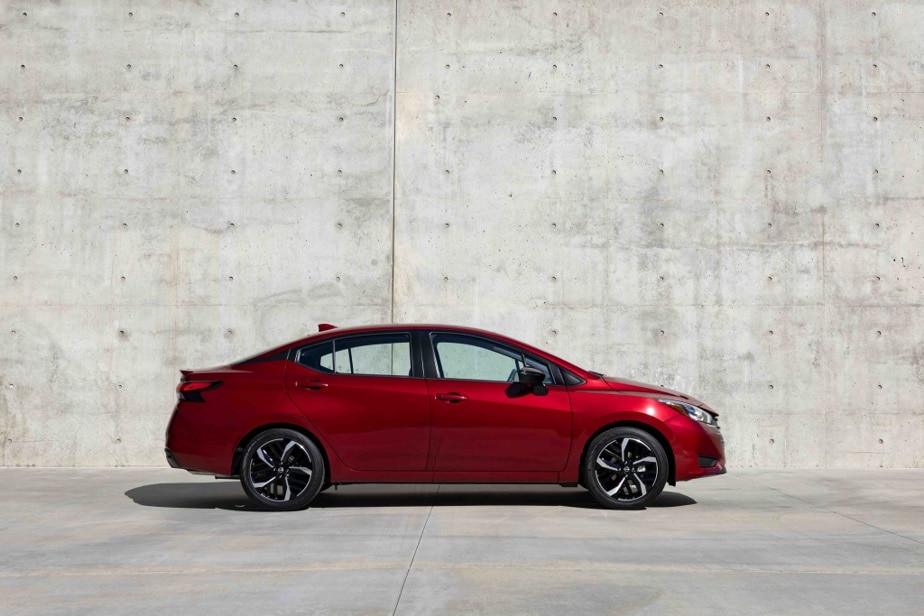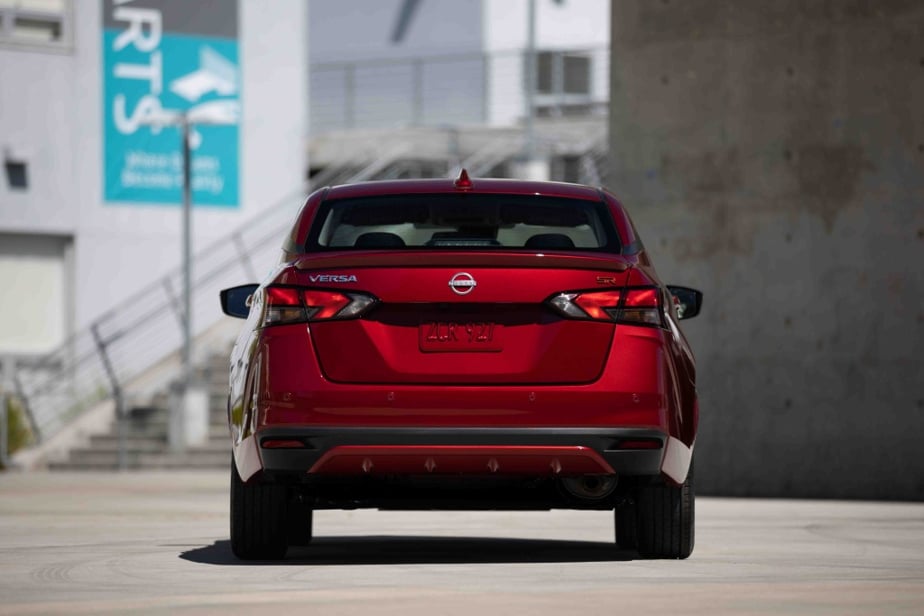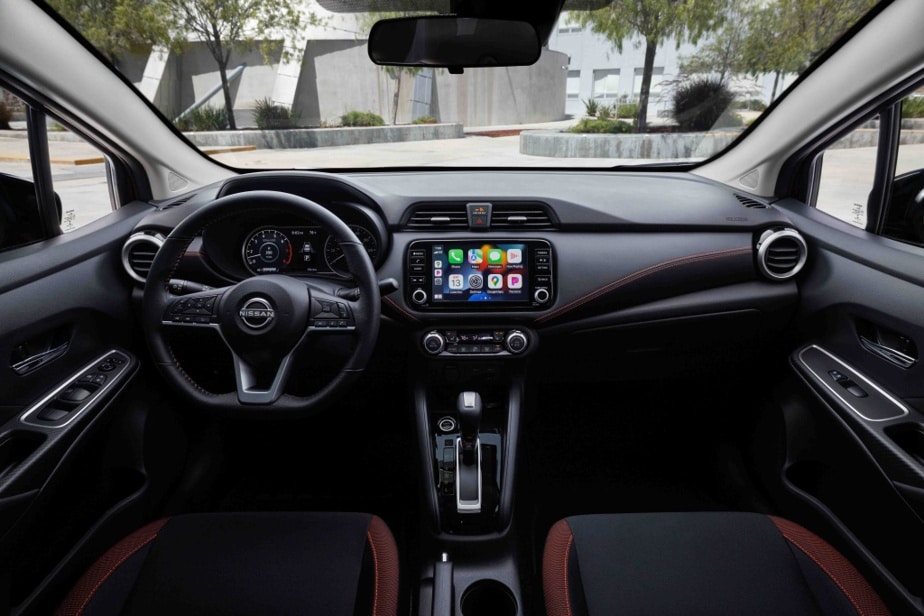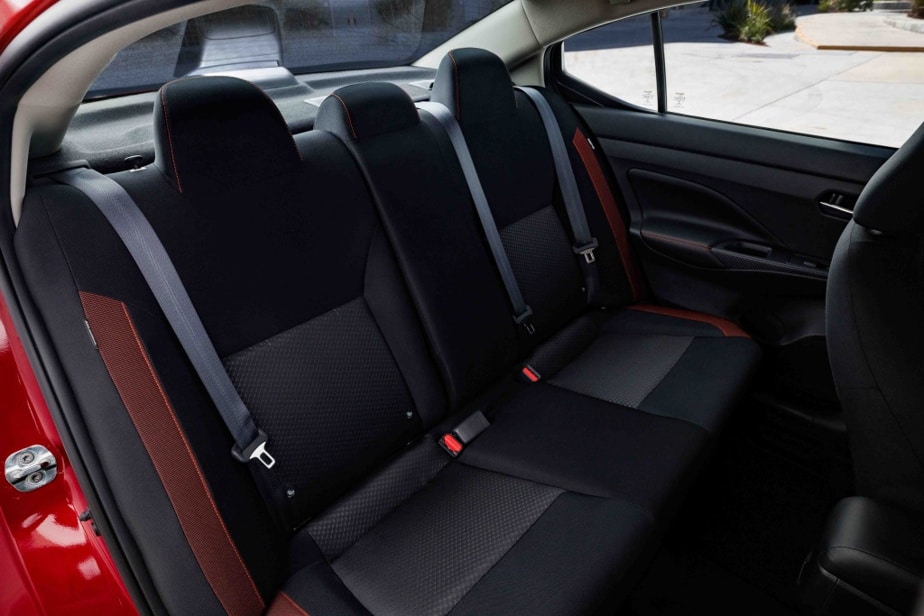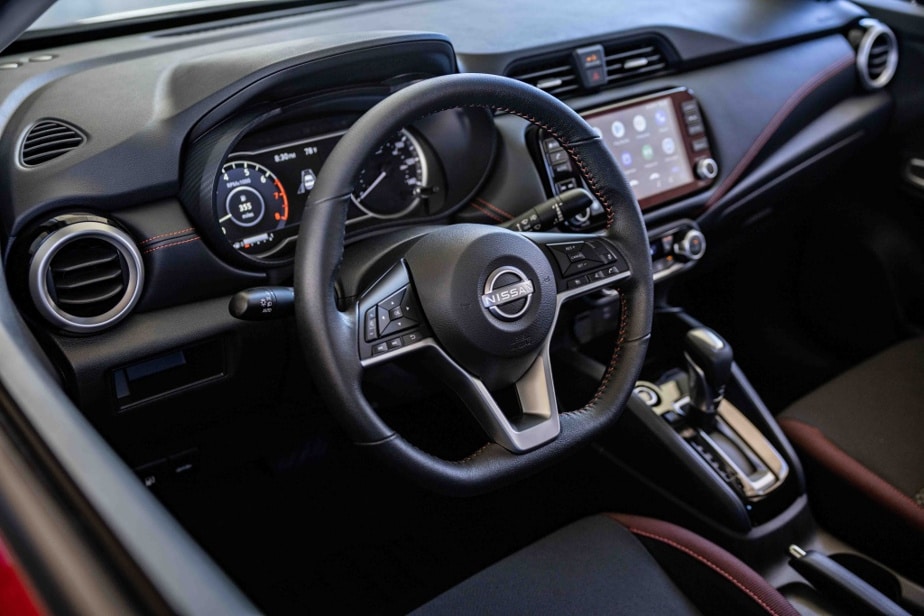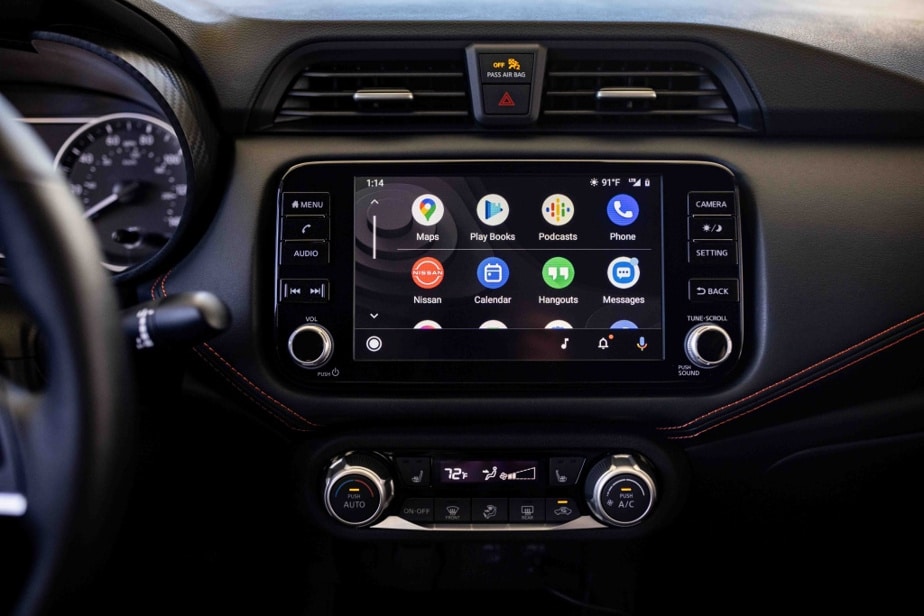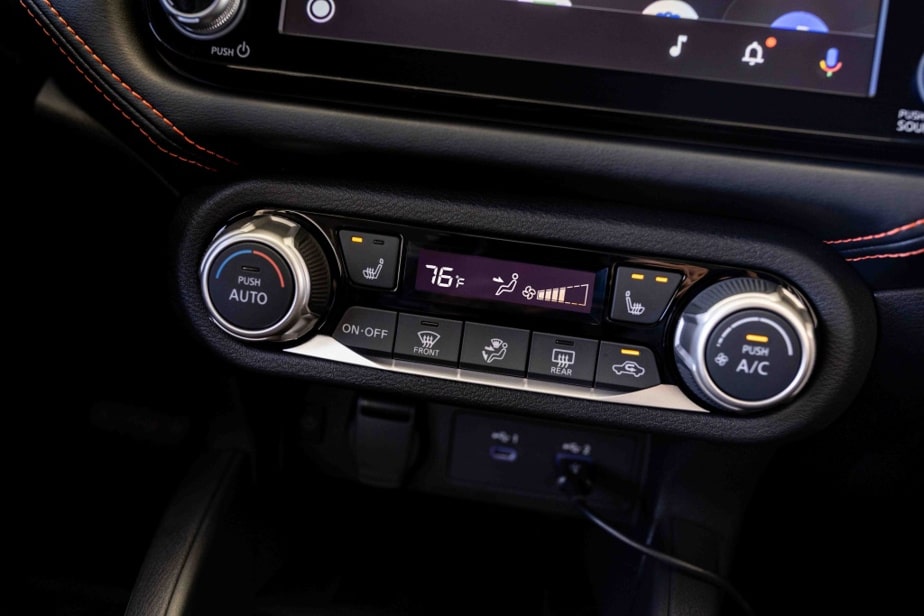A new $20,000 car isn’t as spartan as you might think.
Contents
Moderate your transport
It’s a return to basics, but also to a form of realism. For the price of a Rolls-Royce Ghost, our test bed last week, you could afford 22 Nissan Versas! One will suffice, perhaps you will conclude in the light of this essay.
The fingers of one hand are enough to identify the number of vehicles that are displayed at less than $20,000. And even. The consumer will still have to pay a few thousand dollars more for taxes, transport and preparation. In other words, taking into account all the costs associated with its use, this Versa represents an annual expense of some $7,000. Now, we leave it to you to imagine what it costs to drive a Rolls-Royce.
-
PHOTO PROVIDED BY NISSAN
The Versa does not place great importance on aesthetics. The cutting of sheets (and plastics) had to remain simple, which excluded complex shapes.
-
PHOTO PROVIDED BY NISSAN
With a capacity of 416 L (425 L for the SV and SR), therefore greater than that of a Nissan Sentra or a Mazda3, the luggage compartment is one of the strong points of the Versa.
-
PHOTO PROVIDED BY NISSAN
The seat provides little support and does not invite very long trips.
-
PHOTO PROVIDED BY NISSAN
This Nissan claims to accommodate five occupants without difficulty, but the person sitting in the center of the rear seat will not be comfortable.
-
PHOTO PROVIDED BY NISSAN
The driving position, slightly elevated, is perfectly adjusted thanks to a steering column that is both tilting and telescopic.
-
PHOTO PROVIDED BY NISSAN
The Nissan Versa’s infotainment system
-
PHOTO PROVIDED BY NISSAN
Nissan Versa controls
1/7
The Versa is what you might call a geographically distinctive car. More than 50% of its buyers reside in Quebec. “She plays an important role for us,” said Steve Millette, President and CEO of Nissan Canada. It ensures our presence in a segment where we have a loyal clientele [50 % des clients de la défunte Micra optent aujourd’hui pour une Versa] and sensitive to the price it pays. »
With the Versa, Nissan takes a counter-current discourse of generalist brands. These all aspire to “go upmarket” and, in doing so, eliminate the “cheap” models from their catalog.
The little Nissan proudly claims its vocation as a popular car. And that doesn’t mean rustic or outdated. The many driving aids linked to active safety bear witness to this.
Unsurprisingly, the entry model (S) is more stripped down than the others (SV and SR) in this area. However, with the exception of blind-spot sensors combined with cross-traffic alert (handy in the mall parking lot), there’s no real reason to feel helpless. Even the ugly lane change system is standard across the range.
Were you planning to use a Versa to deliver pizza or provide taxi service (the Versa qualifies)? If so, the S version will do just fine. Otherwise, it is better to aim higher and benefit from some comforts of modern life (heated seats, Android Auto and Apple Car Play, etc.). And with a less sinister presentation, as is the case with the variation that illustrates this report.
Without excess
Archi-traditional, the three-volume silhouette tries not to upset anyone. To be honest, the Versa does not place great importance on aesthetics. The cutting of sheets (and plastics) had to remain simple, which excluded complex shapes. The priority given to habitability also did not allow its designers to worry too much about aerodynamics and subtle plays of light on the bodywork.
That said, this Nissan claims to accommodate five occupants without difficulty, notably by offering them first-rate headroom. True, but the conditions under which the unfortunate (or the unfortunate, it depends) is relegated to the center of the back seat, however, is a challenge. To travel a little more relaxed, it is better to limit access to four people. As for the trunk, it easily defies that of compact sedans. With a capacity of 416 L (425 L for the SV and SR), therefore greater than that of a Nissan Sentra or a Mazda3, this luggage compartment is one of the strengths of the Versa. Too bad, all the same, that only the most expensive versions allow the rear seat backs to fold down.
Bright, the passenger compartment testifies, in its SR livery at the very least, to a fine effort, but the care taken in assembly remains uneven. Uniformly black, the plastics are also of very average quality.
The slightly elevated driving position adjusts perfectly thanks to a tilting and telescoping steering column, but the seat provides little support and does not invite very long trips.
The shortest way
At the wheel, the heading “floats” a bit, the steering always seems numb and the soundproofing proves to be perfectible.
The relaxation of the suspensory elements causes jolts on damaged cobblestones. It even happens to him to heel sometimes. But on properly dressed pavement, the Versa strives to make the ride comfortable. There is no need to worry, in steep curves, that the attitude of the vehicle is disturbed by this too relaxed suspension.
This Versa remains predictable at all times. Even the understeer (tendency to pull straight) that affects it is easily corrected. All you have to do is take your foot off the accelerator and this Nissan immediately finds the desired trajectory.
In addition, the braking is progressive, easy to modulate and rather resistant. And the presence of rear drums also reduces maintenance and repair costs.
Compatible with the anti-pollution standards in force, the engine that drives it lacks breath and discretion (during strong acceleration), but is sufficient for the task given the low weight of the car. The guidance of the five-speed manual transmission lacks precision, but helps to make driving more stimulating. As for the continuously variable transmission (CVT), it still gives this impression of “pedaling in a vacuum”, but it has the merit of reducing the otherwise disappointing fuel consumption of this vehicle. Indeed, even some urban utilities currently show a more moderate appetite for hydrocarbons. This is an invitation to SUV detractors to qualify some of their comments and to potential Versa customers to redo their calculations.
Nissan Versa
Price range
From $18,298 to $22,798
Visible in dealerships
NOW
Consumption
7.4 L/100 km (winter conditions with CVT)
WE love
Simplicity of orders
Predictable behavior
Trunk volume
We love less
High sound level
Unattractive base version (S)
Disappointing fuel consumption for the displacement and size
Our Verdict
The economy is only a facade.
Technical sheet
Engine
- L4 DOHC 1.6L naturally aspirated
- 122 hp at 6300 rpm
- 114 lb-ft of torque at 4000 rpm
Performance
- Empty weight: 1178.6 kg (S)
- Power to weight ratio: 9.66 kg/hp
- Acceleration (0-100 km/h): 9.9 sec
Gearboxes
- Standard: 5-speed manual (S only)
- Optional: automatic CVT (SV and SR standard)
- Drive mode: traction
Tires
- 195/65R15 (S)
- 205/55R16 (SV)
- 205/50R17 (SR)
Tank capacity and recommended gasoline
Dimensions
- Wheelbase: 2620mm
- Length: 4495mm / Height: 1454.5mm
- Width: 1740 mm (exterior mirrors excluded)
Memory box

PHOTO PROVIDED BY NISSAN
Datsun B-210
Its debut dates back to 1957, but we had to wait for the release of the third generation before meeting it. We are in 1973, in full energy crisis, when the Datsun B-210 (marketed elsewhere under the name of Sunny) puts its wheels on our lands. Unsurprisingly, it immediately ranks among the most fuel-efficient cars in its class. It would top the charts in 1978, becoming the first vehicle to consume less than 5 L/100 km (40 mpg), according to the US Environmental Agency (EPA).
To your calculators!

PHOTO PROVIDED BY NISSAN
Nissan Kicks
Nissan considers the Versa has its loyal following, but Steve Millette, president and CEO of the brand in Canada, agrees that the Kicks (our photo) attracts more new customers to its dealerships. We can understand why. The running cost associated with Nissan’s small urban utility is slightly higher ($7270.70 compared to $7105.95 for the Versa). On the other hand, the Kicks currently benefits from a more advantageous interest rate and a higher residual value at the end of 60 months ($8217.67 compared to $6895.36 for the Versa). Ultimately, by opting for the Kicks instead of the Versa, you’ll save $498.56 over a five-year term.
The Press will soon publish the test of the following vehicles: BMW Series 2, Buick Encore GX, Ford Mustang, Subaru Solterra and Toyota Prius Prime. If you own one of these vehicles or are considering purchasing one, we would love to hear from you.

